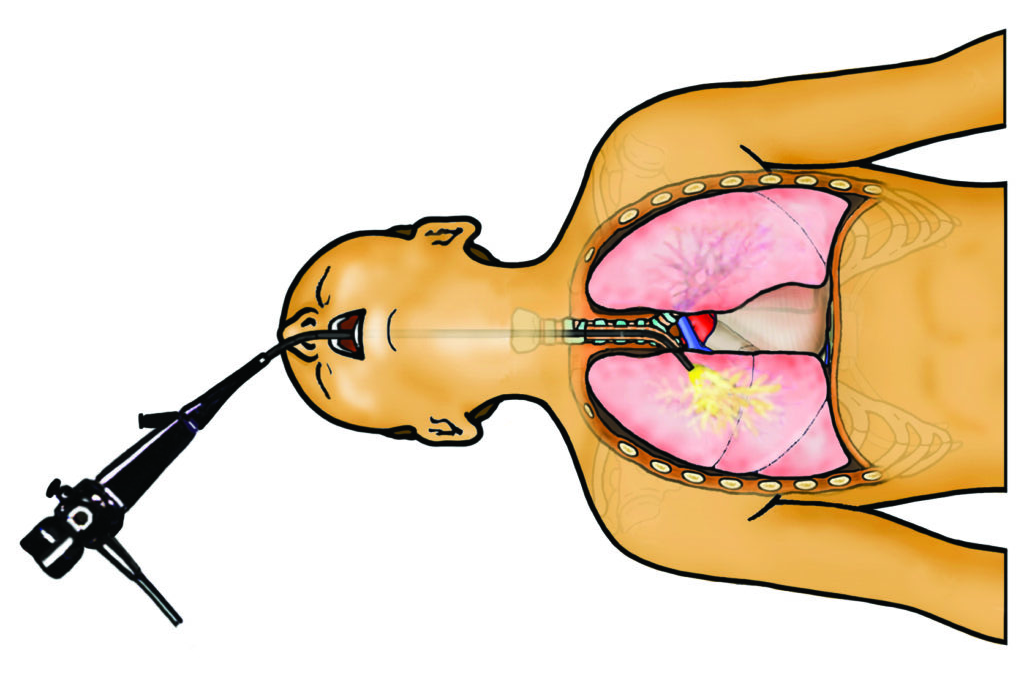What is a bronchoscopy?
A bronchoscopy is an examination of the airways of the lungs. This is done under while the patient is having a deep sleep under a general anaesthetic. A bronchoscope is a thin flexible tube, about the diameter of a pen, with a camera, a light and a suction port at its tip.

The camera and light allows us to see inside the breathing passages of the child’s lungs. There is small suction channel, which allows us take samples of secretions (lavage) or tissue (biopsy) from the lungs. The image that is seen by the camera is shown on a television screen.

Why do a bronchoscopy?
Your doctor has advised you should have a bronchoscopy because you have a problem with your chest. This allows the doctors to look at the anatomy, check that all the bits are where they should be, see if there is anything that shouldn’t be there, and take samples (lavage) of any secretions that might be too deep in the lungs for the child to cough up. These samples are then sent to the laboratory.
What happens on the day of the bronchoscope?
No food should be eaten 6 hours before the bronchoscopy. A small drink of clear, flat water is OK up to 2 hours before the bronchoscopy. This is to stop vomiting during the procedure.
After you arrive on the ward a doctor who will check that the patient is well and examine them. The parents and patient (if old enough) will then be asked to sign the consent form.
If a cannula or drip is needed some “magic” numbing cream will be put on the back of the hand to stop it hurting when the line is being put in. The anaesthetist will make the patient go into a deep sleep. The anaesthetist will use a tube to support the upper airway and breathing. The child will not know it is happening and will not remember it.
The bronchoscope can then be passed down the tube and into the airway. The doctor can then look around the lungs.
The child will wake up from the general anaesthetic in a separate recovery room. Some children wake up straightaway but others may sleep for another two hours or so. About three hours after the procedure, once your child is awake and sitting up on his or her own, he or she will be able to eat and drink.
Unless your child is sick, once he or she has had something to eat and has passed urine, and as long as no other tests are planned, the cannula will be removed and you will be able to go home.
What is Lavage?
Lavage means washing. Salty water is squirted down the bronchoscope into your airways. It helps break up any secretions and it is then sucked back up. These samples are then sent to the laboratory.
Complications
- Unfortunately, any procedure comes with potential complications, just like any medicine comes with side-effects. Fortunately, the complications with bronchoscopy are rare.
- Some children (about 1 in every 10) will cough for a couple of hours after the procedure. It should not take long to feel better.
- A few children have an uncomfortable or sore throat. If you feel sore you can ask for some paracetamol.
- Sometimes children get a high temperature or fever soon after bronchoscopy. If you have a high temperature you can have some paracetamol and this should help. This often occurs the night after the procedure. If it doesn’t settle please seek medical attention.
- Because the bronchoscope may block the flow of air into the airway, or because of the lavage, the level of oxygen in the blood may briefly fall during bronchoscopy.
- The anaesthetist will continuously monitor your child’s oxygen levels throughout the bronchoscopy and extra oxygen can be given or the procedure can be briefly stopped to allow for recovery. Children with very poorly lungs may need oxygen after the procedure as they recover.
- Minor bleeding can occur if the airways are very inflamed or fragile. It can also occur following a biopsy, if this is needed. Any bleeding usually stops on its own, but can be stopped by medication given through the bronchoscope if necessary. It is extremely rare for severe bleeding can occur,
- Very rarely, the airway may be damaged by the bronchoscope, particularly if the lung is already very inflamed or diseased. If the lung is punctured, it may cause an air leak (called a pneumothorax), which can cause the lung to collapse. This is extremely rare, but it is more likely if a biopsy is taken during bronchoscopy. A pneumothorax needs to be diagnosed and treated quickly.
- Every anaesthetic comes with a risk of complications, but this is small. The anaesthetist is trained to deal with any problems that arise.
What else should I know?
If required we will use this opportunity to take blood samples, especially if the patient often gets distressed when having procedures done.
If there is a lot of infection seen in the lungs, we may want to start antibiotics straight away. We will either use the cannula the anaesthetist has placed or put a longer one in called a “long line.” These last longer than cannulae and are more comfortable.
The samples from the lavage can take a week or more to be processed. If there is something found in these samples we will let you know either by telephone or post.